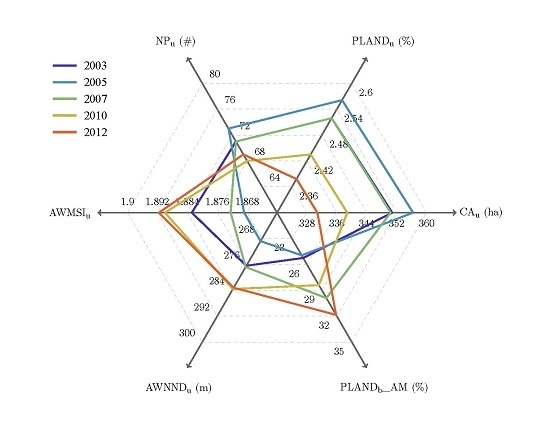The Use of Landscape Metrics and Transfer Learning to Explore Urban Villages in China
Abstract
:1. Introduction
2. Study Areas and Data
3. Methods
3.1. City-UV-Building Hierarchical Landscape Model
3.2. Transfer Learning: Sample and Feature Weighting
3.3. Processing Chain
3.3.1. Preprocessing and Feature Extraction
3.3.2. Sample and Metric Preparation
3.3.3. Scene Representation and Classification
3.3.4. Post-Processing and Spatial-Temporal Analysis
4. Results
4.1. Multi-Temporal Mapping of UVs
4.1.1. Effect of Training Samples on the Result
4.1.2. Effect of Feature Weighting on the Result
4.1.3. Effect of the Scene Size on the Result
4.1.4. Significance of the Landscape Metrics
4.2. Spatiotemporal Statistics and Analysis of UVs
4.2.1. Multi-Temporal Patterns of UVs
4.2.2. Spatial Patterns of UVs
5. Discussion
5.1. Monitoring UVs Using a Remotely-Sensed Data Time Series
5.2. Development of UVs and the Future
6. Conclusions
Acknowledgments
Author Contributions
Conflicts of Interest
Appendix A
References
- Taubenböck, H.; Kraff, N. The Physical Face of Slums: A Structural Comparison of Slums in Mumbai, India, based on Remotely Sensed Data. J. Hous. Built Environ. 2014, 29, 1–24. [Google Scholar] [CrossRef]
- Goebel, A. Sustainable urban development? Low-cost housing challenges in South Africa. Habitat Int. 2007, 31, 291–302. [Google Scholar] [CrossRef]
- O’Hare, G.; Barke, M. The favelas of Rio de Janeiro: A temporal and spatial analysis. GeoJournal 2002, 56, 225–240. [Google Scholar] [CrossRef]
- UN-Habitat. Enhancing Urban Safety and Security: Global Report on Human Settlements; Earthsca: London, UK, 2007. [Google Scholar]
- Liu, Y.; He, S.; Wu, F.; Webster, C. Urban villages under China’s rapid urbanization: Unregulated assets and transitional neighbourhoods. Habitat Int. 2010, 34, 135–144. [Google Scholar] [CrossRef]
- Li, Z.; Wu, F. Residential Satisfaction in China’s Informal Settlements: A Case Study of Beijing, Shanghai, and Guangzhou. Urban Geogr. 2013, 34, 923–949. [Google Scholar] [CrossRef]
- Ghasempour, A. Informal Settlement: Concept, Challenges, and Intervention Approaches. Spec. J. Arch. Constr. 2015, 1, 10–16. [Google Scholar]
- Wang, Y.P.; Wang, Y.; Wu, J. Urbanization and Informal Development in China: Urban Villages in Shenzhen. Int. J. Urban Reg. Res. 2009, 33, 957–973. [Google Scholar] [CrossRef]
- Hao, P.; Hooimeijer, P.; Sliuzas, R.; Geertman, S. What Drives the Spatial Development of Urban Villages in China? Urban Stud. 2013, 50, 3394–3411. [Google Scholar] [CrossRef]
- Tian, L. The Chengzhongcun Land Market in China: Boon or Bane?—A Perspective on Property Rights. Int. J. Urban Reg. Res. 2008, 32, 282–304. [Google Scholar] [CrossRef]
- Li, L.H.; Li, X. Redevelopment of Urban Villages in Shenzhen, China—An Analysis of Power Relations and Urban Coalitions. Habitat Int. 2011, 35, 426–434. [Google Scholar]
- Chung, H.; Zhou, S.H. Planning for Plural Groups? Villages-in-the-city Redevelopment in Guangzhou City, China. Int. Plan. Stud. 2011, 16, 333–353. [Google Scholar] [CrossRef]
- Song, Y.; Zenou, Y.; Ding, C. Let’s Not Throw the Baby Out with the Bath Water: The Role of Urban Villages in Housing Rural Migrants in China. Urban Stud. 2008, 45, 313–330. [Google Scholar]
- Huang, X.; Liu, H.; Zhang, L. Spatiotemporal Detection and Analysis of Urban Villages in Mega City Regions of China Using High-Resolution Remotely Sensed Imagery. IEEE Trans. Geosci. Remote Sens. 2015, 53, 3639–3657. [Google Scholar] [CrossRef]
- D’Oleire Oltmanns, S.; Coenradie, B.; Kleinschmit, B. An Object-Based Classification Approach for Mapping Migrant Housing in the Mega-Urban Area of the Pearl River Delta (China). Remote Sens. 2011, 3, 1710. [Google Scholar] [CrossRef]
- Veljanovski, T.; Kanjir, U.; Pehani, P.; Oštir, K.; Kovačič, P. Object-Based Image Analysis of VHR Satellite Imagery for Population Estimation in Informal Settlement Kibera-Nairobi, Kenya. In Remote Sensing—Applications; InTech: Rijeka, Croatia, 2012; pp. 407–436. [Google Scholar]
- Graesser, J.; Cheriyadat, A.; Vatsavai, R.R.; Chandola, V.; Long, J.; Bright, E. Image Based Characterization of Formal and Informal Neighborhoods in an Urban Landscape. IEEE J. Sel. Top. Appl. Earth Obs. Remote Sens. 2012, 5, 1164–1176. [Google Scholar] [CrossRef]
- Kit, O.; Lüdeke, M. Automated detection of slum area change in Hyderabad, India using multitemporal satellite imagery. ISPRS J. Photogramm. Remote Sens. 2013, 83, 130–137. [Google Scholar] [CrossRef]
- Hofmann, P.; Taubenbock, H.; Werthmann, C. Monitoring and Modelling of Informal Settlements—A Review on Recent Developments and Challenges. In Proceedings of the 2015 Joint Urban Remote Sensing Event, Lausanne, Switzerland, 30 March–1 April 2015; pp. 1–4. [Google Scholar]
- Duque, J.C.; Patino, J.E.; Ruiz, L.A.; Pardo-Pascual, J.E. Measuring intra-urban poverty using land cover and texture metrics derived from remote sensing data. Lands. Urban Plan. 2015, 135, 11–21. [Google Scholar] [CrossRef]
- Kohli, D.; Sliuzas, R.; Stein, A. Urban slum detection using texture and spatial metrics derived from satellite imagery. J. Spat. Sci. 2016, 61, 405–426. [Google Scholar] [CrossRef]
- Kuffer, M.; Pfeffer, K.; Sliuzas, R. Slums from Space—15 Years of Slum Mapping Using Remote Sensing. Remote Sens. 2016, 8. [Google Scholar] [CrossRef]
- Hofmann, P.; Strobl, J.; Blaschke, T.; Kux, H. Detecting informal settlements from QuickBird data in Rio de Janeiro using an object based approach. In Object-Based Image Analysis; Lecture Notes in Geoinformation and Cartography; Blaschke, T., Lang, S., Hay, G., Eds.; Springer: Berlin/Heidelberg, Germany, 2008; pp. 531–553. [Google Scholar]
- Owen, K.K.; Wong, D.W. An approach to differentiate informal settlements using spectral, texture, geomorphology and road accessibility metrics. Appl. Geogr. 2013, 38, 107–118. [Google Scholar] [CrossRef]
- Miller, R.B.; Small, C. Cities from space: Potential applications of remote sensing in urban environmental research and policy. Environ. Sci. Policy 2003, 6, 129–137. [Google Scholar] [CrossRef]
- Schneider, A.; Mertes, C.M. Expansion and growth in Chinese cities, 1978–2010. Environ. Res. Lett. 2014, 9, 024008. [Google Scholar] [CrossRef]
- Li, X.; Gong, P.; Liang, L. A 30-year (1984–2013) record of annual urban dynamics of Beijing City derived from Landsat data. Remote Sens. Environ. 2015, 166, 78–90. [Google Scholar] [CrossRef]
- Klotz, M.; Kemper, T.; Geiß, C.; Esch, T.; Taubenböck, H. How good is the map? A multi-scale cross-comparison framework for global settlement layers: Evidence from Central Europe. Remote Sens. Environ. 2016, 178, 191–212. [Google Scholar] [CrossRef]
- Al, S.; Shan, P.C.H.; Juhre, C.; Valin, I.; Wang, C. (Eds.) Villages in the City: A Guide to South China’s Informal Settlements; Hong Kong University Press: Hong Kong, China, 2014. [Google Scholar]
- Stasolla, M.; Gamba, P. Exploiting Spatial Patterns For Informal Settlement Detection Inarid Environments Using Optical Spaceborne Data. Int. Arch. Photogramm. Remote Sens. Spat. Inf. Sci. 2007, 36, W49A. [Google Scholar]
- Kohli, D.; Warwadekar, P.; Kerle, N.; Sliuzas, R.; Stein, A. Transferability of Object-Oriented Image Analysis Methods for Slum Identification. Remote Sens. 2013, 5, 4209. [Google Scholar] [CrossRef]
- Kuffer, M.; Pfeffer, K.; Sliuzas, R.; Baud, I. Extraction of Slum Areas From VHR Imagery Using GLCM Variance. IEEE J. Sel. Top. Appl. Earth Obs. Remote Sens. 2016, 9, 1830–1840. [Google Scholar] [CrossRef]
- Remer, L.; Wald, A.; Kaufman, Y. Angular and seasonal variation of spectral surface reflectance ratios: Implications for the remote sensing of aerosol over land. IEEE Trans. Geosci. Remote Sens. 2001, 39, 275–283. [Google Scholar] [CrossRef]
- Verbesselt, J.; Hyndman, R.; Newnham, G.; Culvenor, D. Detecting trend and seasonal changes in satellite image time series. Remote Sens. Environ. 2010, 114, 106–115. [Google Scholar] [CrossRef]
- Taubenböck, H.; Wiesner, M. The Spatial Network of Megaregions—Types of Connectivity Between Cities Based on Settlement Patterns Derived From EO-data. Comput. Environ. Urban Syst. 2015, 54, 165–180. [Google Scholar] [CrossRef]
- McGarigal, K.; Marks, B.J. Spatial Pattern Analysis Program for Quantifying Landscape Structure; U.S. Department of Agriculture, Forest Service, Pacific Northwest Research Station: Portland, OR, USA, 1995.
- O’Neill, R.V.; Krummel, J.R.; Gardner, R.H.; Sugihara, G.; Jackson, B.; DeAngelis, D.L.; Milne, B.T.; Turner, M.G.; Zygmunt, B.; Christensen, S.W.; et al. Indices of Landscape Pattern. Lands. Ecol. 1988, 1, 153–162. [Google Scholar] [CrossRef]
- Herold, M.; Scepan, J.; Clarke, K.C. The use of remote sensing and landscape metrics to describe structures and changes in urban land uses. Environ. Plan. A 2002, 34, 1443–1458. [Google Scholar] [CrossRef]
- Ji, W.; Ma, J.; Twibell, R.W.; Underhill, K. Characterizing urban sprawl using multi-stage remote sensing images and landscape metrics. Comput. Environ. Urban Syst. 2006, 30, 861–879. [Google Scholar] [CrossRef]
- Huang, J.; Lu, X.; Sellers, J.M. A global comparative analysis of urban form: Applying spatial metrics and remote sensing. Lands. Urban Plan. 2007, 82, 184–197. [Google Scholar] [CrossRef]
- Li, J.; Song, C.; Cao, L.; Zhu, F.; Meng, X.; Wu, J. Impacts of landscape structure on surface urban heat islands: A case study of Shanghai, China. Remote Sens. Environ. 2011, 115, 3249–3263. [Google Scholar] [CrossRef]
- Plexida, S.G.; Sfougaris, A.I.; Ispikoudis, I.P.; Papanastasis, V.P. Selecting landscape metrics as indicators of spatial heterogeneity—A comparison among Greek landscapes. Int. J. Appl. Earth Obs. Geoinf. 2014, 26, 26–35. [Google Scholar] [CrossRef]
- Taubenböck, H.; Wiesner, M.; Felbier, A.; Marconcini, M.; Esch, T.; Dech, S. New Dimensions of Urban Landscapes: The Spatio-temporal Evolution From a Polynuclei Area to a Mega-region Based on Remote Sensing Data. Appl. Geogr. 2014, 47, 137–153. [Google Scholar] [CrossRef]
- Pesaresi, M.; Gerhardinger, A.; Kayitakire, F. A Robust Built-Up Area Presence Index by Anisotropic Rotation-Invariant Textural Measure. IEEE J. Sel. Top. Appl. Earth Obs. Remote Sens. 2008, 1, 180–192. [Google Scholar] [CrossRef]
- Huang, X.; Zhang, L. A Multidirectional and Multiscale Morphological Index for Automatic Building Extraction From Multispectral GeoEye-1 Imagery. Photogramm. Eng. Remote Sens. 2011, 77, 721–732. [Google Scholar] [CrossRef]
- Huang, X.; Zhang, L. Morphological building/shadow index for building extraction from high-resolution imagery over urban areas. IEEE J. Sel. Top. Appl. Earth Obs. Remote Sens. 2012, 5, 161–172. [Google Scholar] [CrossRef]
- Syrris, V.; Ferri, S.; Ehrlich, D.; Pesaresi, M. Image Enhancement and Feature Extraction Based on Low-Resolution Satellite Data. IEEE J. Sel. Top. Appl. Earth Obs. Remote Sens. 2015, 8, 1986–1995. [Google Scholar] [CrossRef]
- Wen, D.; Huang, X.; Zhang, L.; Benediktsson, J. A Novel Automatic Change Detection Method for Urban High-Resolution Remotely Sensed Imagery Based on Multiindex Scene Representation. IEEE Trans. Geosci. Remote Sens. 2016, 54, 609–625. [Google Scholar] [CrossRef]
- Lagro, J. Assessing Patch Shape in Landscape Mosaics. Photogramm. Eng. Remote Sens. 1991, 57, 285–293. [Google Scholar]
- Herold, M.; Goldstein, N.C.; Clarke, K.C. The Spatiotemporal Form of Urban Growth: Measurement, Analysis and Modeling. Remote Sens. Environ. 2003, 86, 286–302. [Google Scholar] [CrossRef]
- Bechle, M.J.; Millet, D.B.; Marshall, J.D. Effects of Income and Urban Form on Urban NO2: Global Evidence from Satellites. Environ. Sci. Technol. 2011, 45, 4914–4919. [Google Scholar] [CrossRef] [PubMed]
- Kohli, D.; Sliuzas, R.; Kerle, N.; Stein, A. An Ontology of Slums for Image-based Classification. Comput. Environ. Urban Syst. 2012, 36, 154–163. [Google Scholar] [CrossRef]
- Frohn, R.C. The use of landscape pattern metrics in remote sensing image classification. Int. J. Remote Sens. 2006, 27, 2025–2032. [Google Scholar] [CrossRef]
- National Bureau of Statistics of China. China City Statistical Yearbook; China Statistics Press: Beijing, China, 2011. [Google Scholar]
- Matasci, G.; Volpi, M.; Tuia, D.; Kanevski, M. Transfer component analysis for domain adaptation in image classification. Proc. SPIE 2011. [Google Scholar] [CrossRef]
- Bahirat, K.; Bovolo, F.; Bruzzone, L.; Chaudhuri, S. A Novel Domain Adaptation Bayesian Classifier for Updating Land-Cover Maps With Class Differences in Source and Target Domains. IEEE Trans. Geosci. Remote Sens. 2012, 50, 2810–2826. [Google Scholar] [CrossRef]
- Demir, B.; Bovolo, F.; Bruzzone, L. Classification of Time Series of Multispectral Images With Limited Training Data. IEEE Trans. Image Process. 2013, 22, 3219–3233. [Google Scholar] [CrossRef] [PubMed]
- Liu, Y.; Li, X. Domain adaptation for land use classification: A spatio-temporal knowledge reusing method. ISPRS J. Photogramm. Remote Sens. 2014, 98, 133–144. [Google Scholar] [CrossRef]
- Pan, S.J.; Yang, Q. A Survey on Transfer Learning. IEEE Trans. Knowl. Data Eng. 2010, 22, 1345–1359. [Google Scholar] [CrossRef]
- Sun, Q.; Chattopadhyay, R.; Panchanathan, S.; Ye, J. A two-stage weighting framework for multi-source domain adaptation. In Advances in Neural Information Processing Systems; Shawe-Taylor, J., Zemel, R., Bartlett, P., Pereira, F., Weinberger, K., Eds.; Curran Associates, Inc.: Red Hook, NY, USA, 2011; pp. 505–513. [Google Scholar]
- Breiman, L.; Friedman, J.; Stone, C.J.; Olshen, R.A. Classification and Regression Trees; CRC: New York, NY, USA, 1984. [Google Scholar]
- Louppe, G.; Wehenkel, L.; Sutera, A.; Geurts, P. Understanding variable importances in forests of randomized trees. In Advances in Neural Information Processing Systems; Burges, C., Bottou, L., Welling, M., Ghahramani, Z., Weinberger, K., Eds.; Curran Associates, Inc.: Red Hook, NY, USA, 2013; pp. 431–439. [Google Scholar]
- Immitzer, M.; Atzberger, C.; Koukal, T. Tree Species Classification with Random Forest Using Very High Spatial Resolution 8-Band WorldView-2 Satellite Data. Remote Sens. 2012, 4, 2661–2693. [Google Scholar] [CrossRef]
- Belgiu, M.; Tomljenovic, I.; Lampoltshammer, T.; Blaschke, T.; Höfle, B. Ontology-Based Classification of Building Types Detected from Airborne Laser Scanning Data. Remote Sens. 2014, 6, 1347–1366. [Google Scholar] [CrossRef]
- Fernández-Delgado, M.; Cernadas, E.; Barro, S.; Amorim, D. Do we Need Hundreds of Classifiers to Solve Real World Classification Problems? J. Mach. Learn. Res. 2014, 15, 3133–3181. [Google Scholar]
- Chang, M.W.; Lin, H.T.; Tsai, M.H.; Ho, C.H.; Yu, H.F. LIBSVM with Instance Weight. Available online: http://www.csie.ntu.edu.tw/ cjlin/libsvmtools/#weightsfordatainstances (accessed on 31 May 2016).
- Anselin, L. Local indicators of spatial association—LISA. Geogr. Anal. 1995, 27, 93–115. [Google Scholar] [CrossRef]
- Anselin, L.; Syabri, I.; Kho, Y. GeoDa: An Introduction to Spatial Data Analysis. Geogr. Anal. 2006, 38, 5–22. [Google Scholar] [CrossRef]
- Small, C. High spatial resolution spectral mixture analysis of urban reflectance. Remote Sens. Environ. 2003, 88, 170–186. [Google Scholar] [CrossRef]
- Hofmann, P. Detecting informal settlements from IKONOS image data using methods of object oriented image analysis—An example from Cape Town (South Africa). In Proceedings of the 2nd International Symposium on Remote Sensing of Urban Areas (URS), Regensburg, Germany, 22–23 June 2001. [Google Scholar]
- Huang, X.; Zhang, L. An adaptive mean-shift analysis approach for object extraction and classification from urban hyperspectral imagery. IEEE Trans. Geosci. Remote Sens. 2008, 46, 4173–4185. [Google Scholar] [CrossRef]
- Myint, S.; Gober, P.; Brazel, A.; Grossman-Clarke, S.; Weng, Q. Per-pixel vs. object-based classification of urban land cover extraction using high spatial resolution imagery. Remote Sens. Environ. 2011, 115, 1145–1161. [Google Scholar] [CrossRef]
- De Pinho, C.M.D.; Fonseca, L.M.G.; Korting, T.S.; de Almeida, C.M.; Kux, H.J.H. Land-cover classification of an intra-urban environment using high-resolution images and object-based image analysis. Int. J. Remote Sens. 2012, 33, 5973–5995. [Google Scholar] [CrossRef]
- Kuffer, M.; Barros, J.; Sliuzas, R.V. The Development of a Morphological Unplanned Settlement Index using Very-High-Resolution (VHR) Imagery. Comput. Environ. Urban Syst. 2014, 48, 138–152. [Google Scholar] [CrossRef]
- Stasolla, M.; Gamba, P. Mapping informal settlements with a GUS land use legend. In Proceedings of the IEEE International Conference on Geoscience and Remote Sensing Symposium, Denver, CO, USA, 31 July–4 August 2006; pp. 3786–3789. [Google Scholar]
- Kit, O.; Lüdeke, M.; Reckien, D. Texture-based identification of urban slums in Hyderabad, India using remote sensing data. Appl. Geogr. 2012, 32, 660–667. [Google Scholar] [CrossRef]
- Zhang, X.; Hu, J.; Skitmore, M.; Leung, B. Inner-City Urban Redevelopment in China Metropolises and the Emergence of Gentrification: Case of Yuexiu, Guangzhou. J. Urban Plan. Dev. 2014, 140, 05014004. [Google Scholar] [CrossRef]
- Ni, P.; Oyeyinka, B.; Chen, F. Changing the Rules of Development: Institutional Innovation in Rebuilding China’s Shantytowns. In Urban Innovation and Upgrading in China Shanty Towns; Springer: Berlin/Heidelberg, Germany, 2015; pp. 1–22. [Google Scholar]
- Zhang, L. The Political Economy of Informal Settlements in Post-socialist China: The Case of Chengzhongcun(s). Geoforum 2011, 42, 473–483. [Google Scholar] [CrossRef]
- Ma, T.; Zhou, C.; Pei, T.; Haynie, S.; Fan, J. Quantitative estimation of urbanization dynamics using time series of DMSP/OLS nighttime light data: A comparative case study from China’s cities. Remote Sens. Environ. 2012, 124, 99–107. [Google Scholar] [CrossRef]
- Zacharias, J.; Tang, Y. Restructuring and repositioning Shenzhen, China’s new mega city. Prog. Plan. 2010, 73, 209–249. [Google Scholar] [CrossRef]
- Zeng, C.; Liu, Y.; Stein, A.; Jiao, L. Characterization and spatial modeling of urban sprawl in the Wuhan Metropolitan Area, China. Int. J. Appl. Earth Obs. Geoinf. 2015, 34, 10–24. [Google Scholar] [CrossRef]
- Liao, B.; Wong, D.W. Changing urban residential patterns of Chinese migrants: Shanghai, 2000–2010. Urban Geogr. 2015, 36, 109–126. [Google Scholar] [CrossRef]
- Wu, F.; Zhang, F.; Webster, C. Informality and the Development and Demolition of Urban Villages in the Chinese Peri-urban Area. Urban Stud. 2013, 50, 1919–1934. [Google Scholar] [CrossRef]
- Lin, Y.; De Meulder, B. A conceptual framework for the strategic urban project approach for the sustainable redevelopment of “villages in the city” in Guangzhou. Habitat Int. 2012, 36, 380–387. [Google Scholar] [CrossRef]
- Ye, L. Urban regeneration in China: Policy, development, and issues. Local Econ. 2011, 26, 337–347. [Google Scholar] [CrossRef]
- Cheng, Z. The Changing and different patterns of urban redevelopment in China: A study of three inner-city neighborhoods. Community Dev. 2012, 43, 430–450. [Google Scholar] [CrossRef]
- He, S.; Wu, F. Property-Led Redevelopment in Post-Reform China: A Case Study of Xintiandi Redevelopment Project in Shanghai. J. Urban Aff. 2005, 27, 1–23. [Google Scholar] [CrossRef]
- Shin, H.B. Residential Redevelopment and the Entrepreneurial Local State: The Implications of Beijing’s Shifting Emphasis on Urban Redevelopment Policies. Urban Stud. 2009, 46, 2815–2839. [Google Scholar] [CrossRef]
- Yao, S.; Luo, D.; Wang, J. Housing Development and Urbanisation in China. World Econ. 2014, 37, 481–500. [Google Scholar] [CrossRef]
- Wu, D.; Gao, P.; Dong, J. Impact of Subsidy on Low-rent Housing Lessees’ Welfare in China. Int. J. Inf. Technol. Decis. Mak. 2012, 11, 643–660. [Google Scholar] [CrossRef]
- Li, X.; Shen, Z.; Kobayashi, F. Planning review on residential environment of low rent housing: A method to solve low-rent housing space insufficiency in Tianjin, China. Int. Rev. Spat. Plan. Sustain. Dev. 2015, 3, 50–62. [Google Scholar] [CrossRef]
- Liu, Y.; Luo, T.; Liu, Z.; Kong, X.; Li, J.; Tan, R. A Comparative Analysis of Urban and Rural Construction Land Use Change and Driving Forces: Implications for Urban–rural Coordination Development in Wuhan, Central China. Habitat Int. 2015, 47, 113–125. [Google Scholar] [CrossRef]
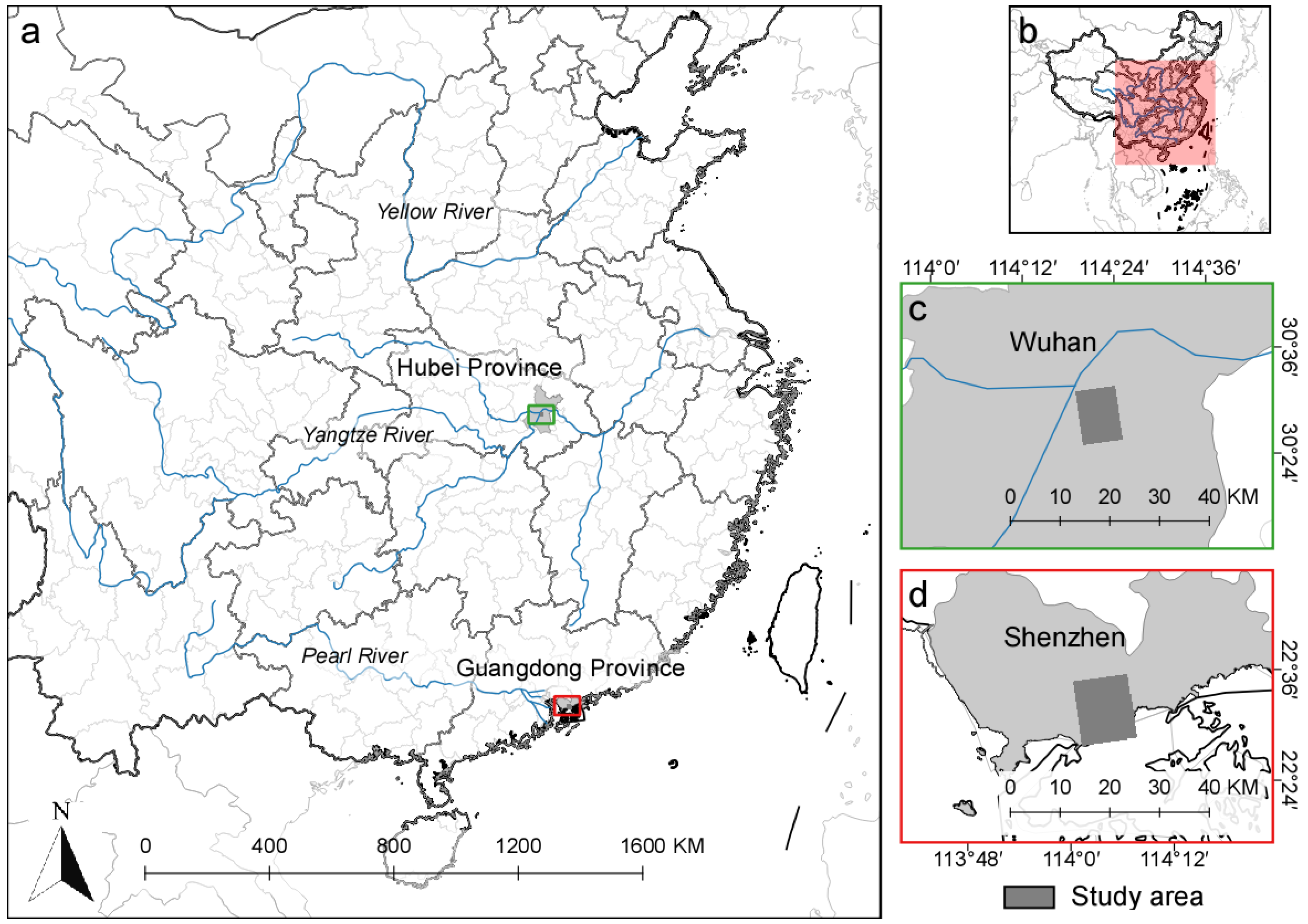
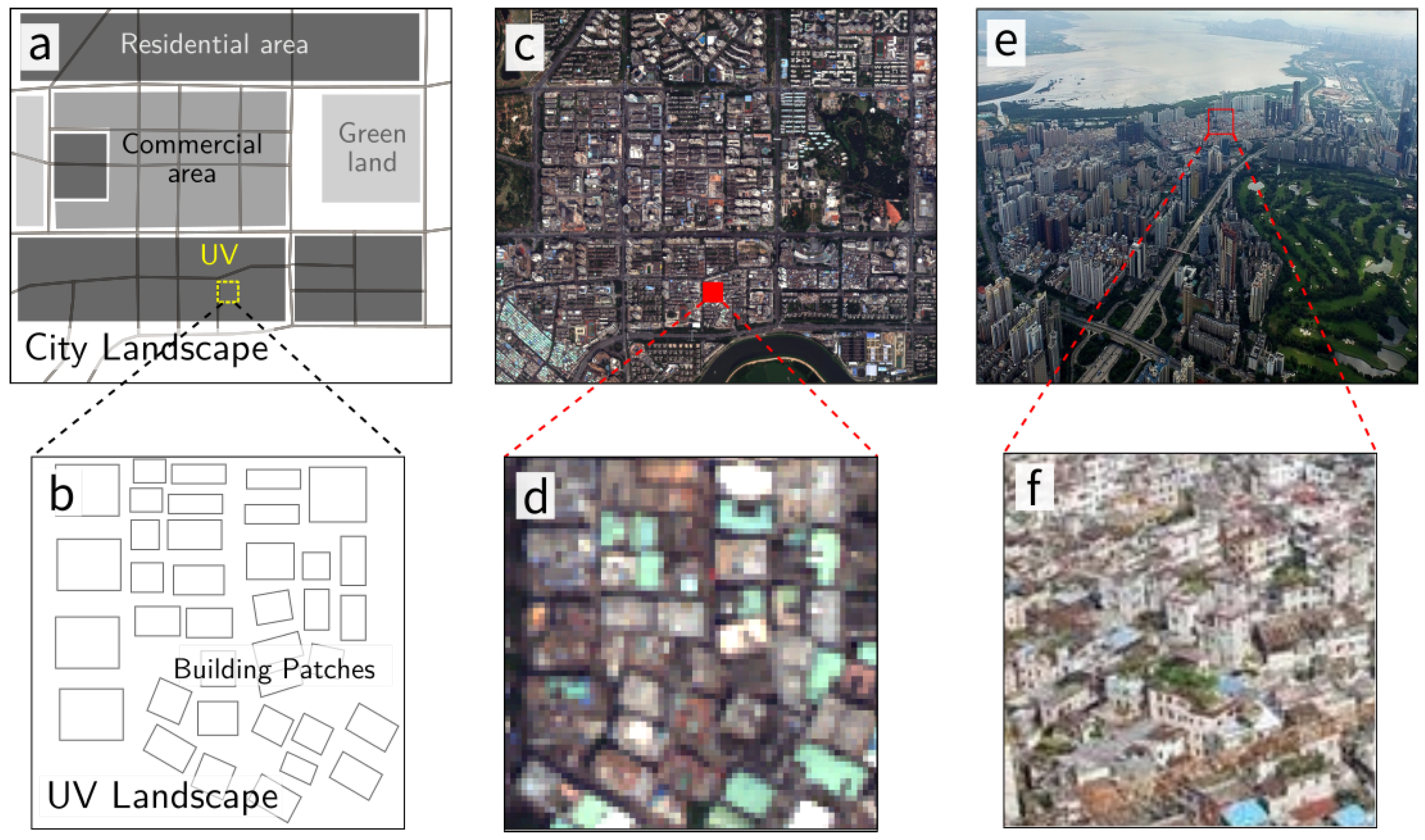
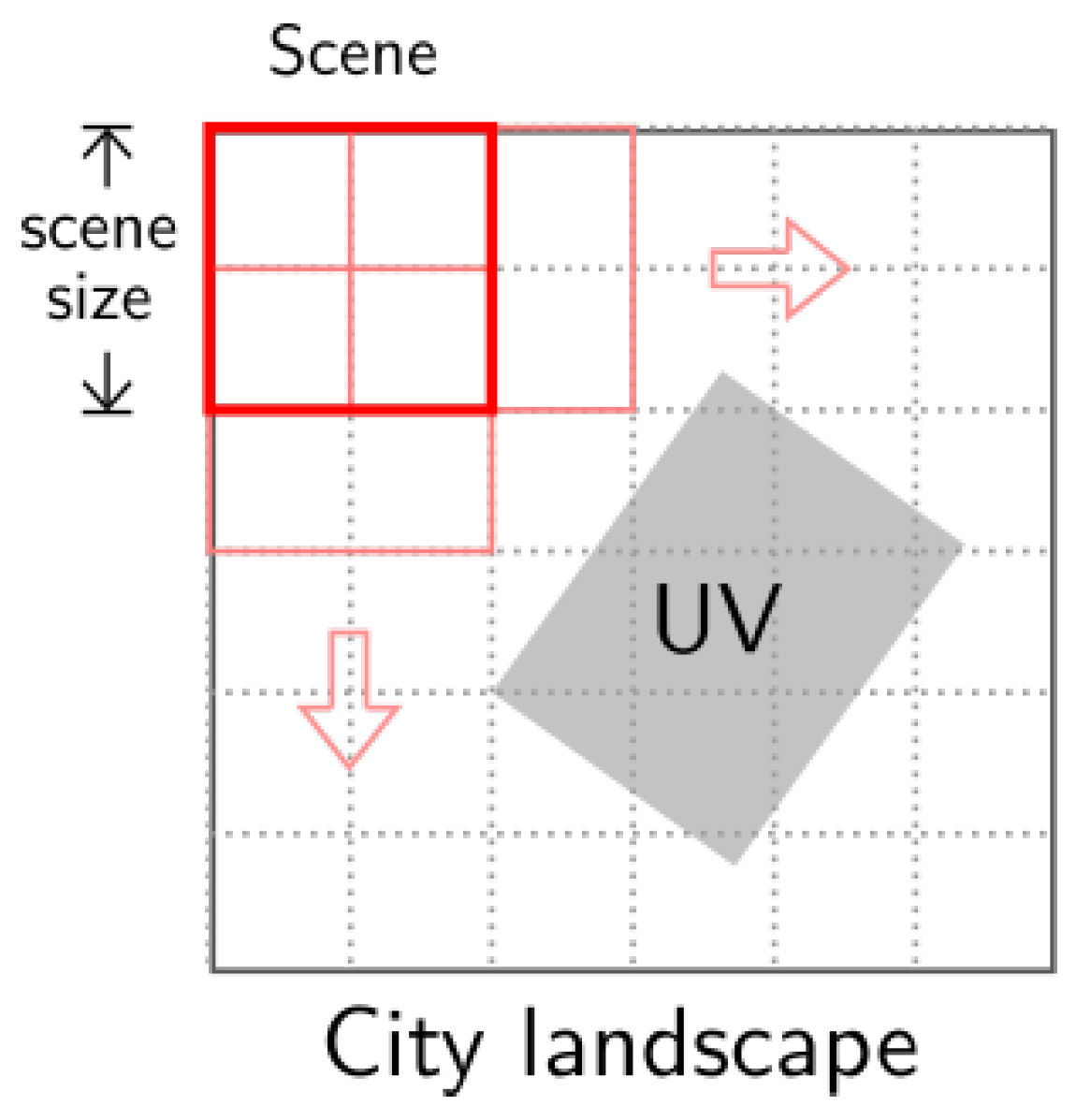

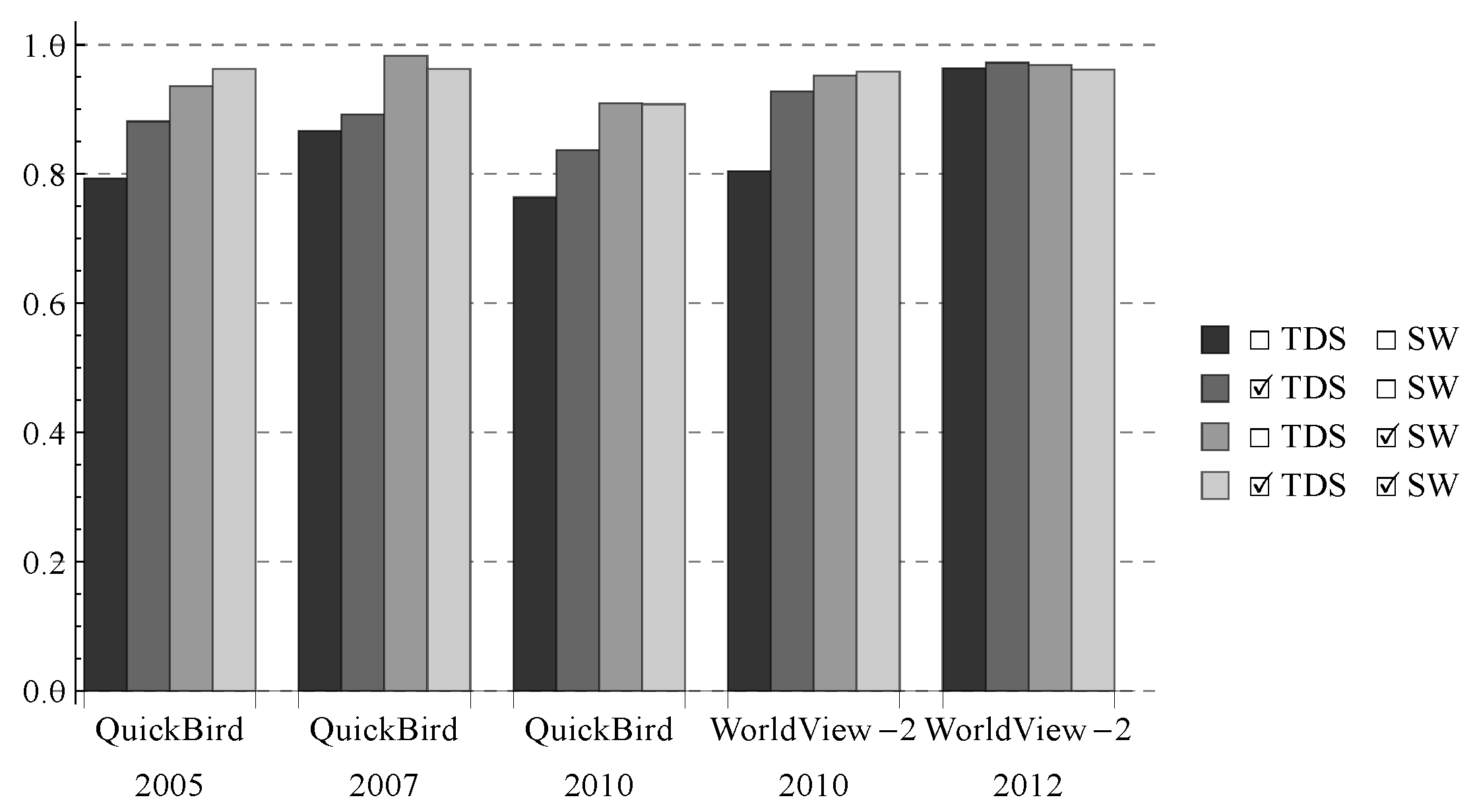
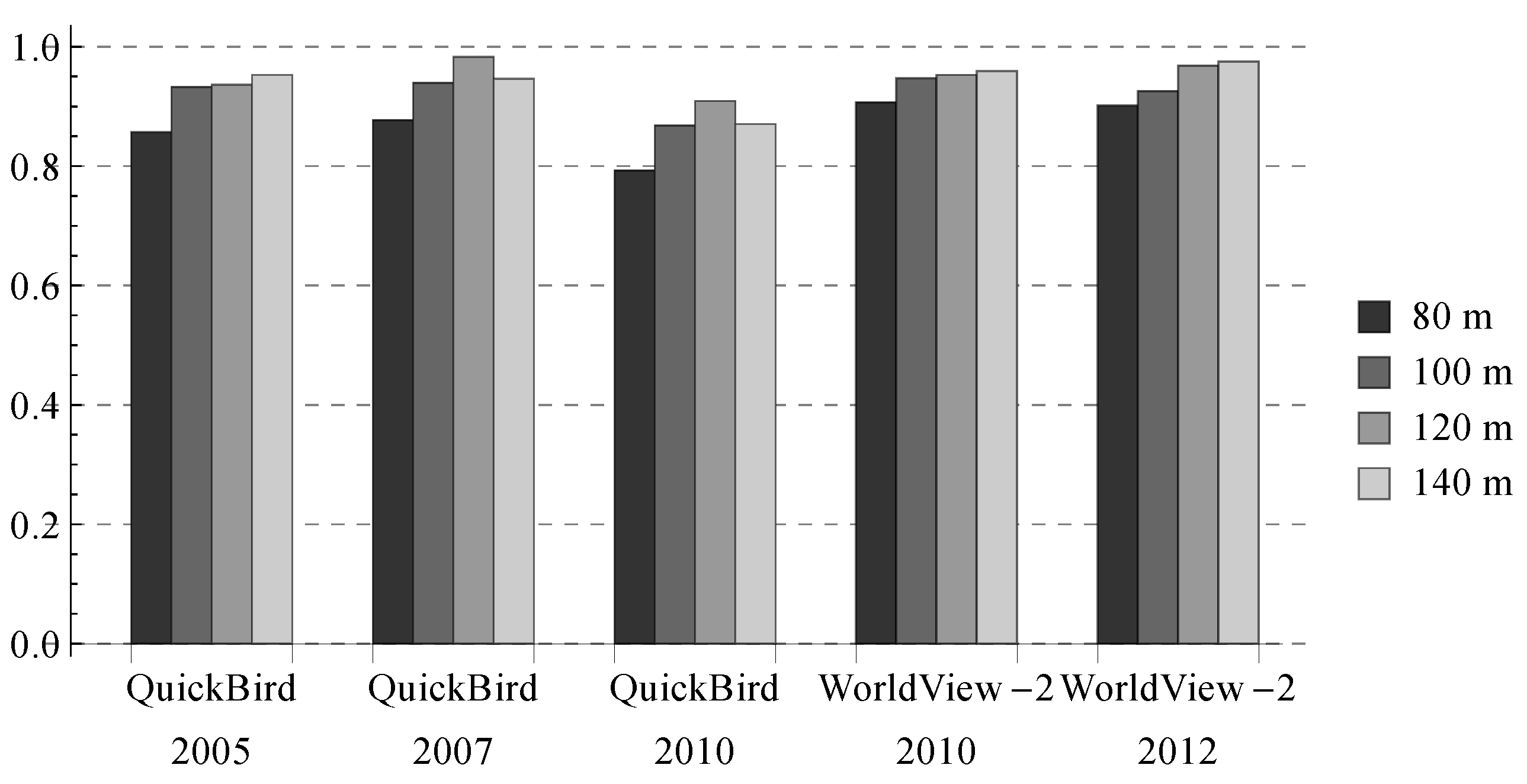

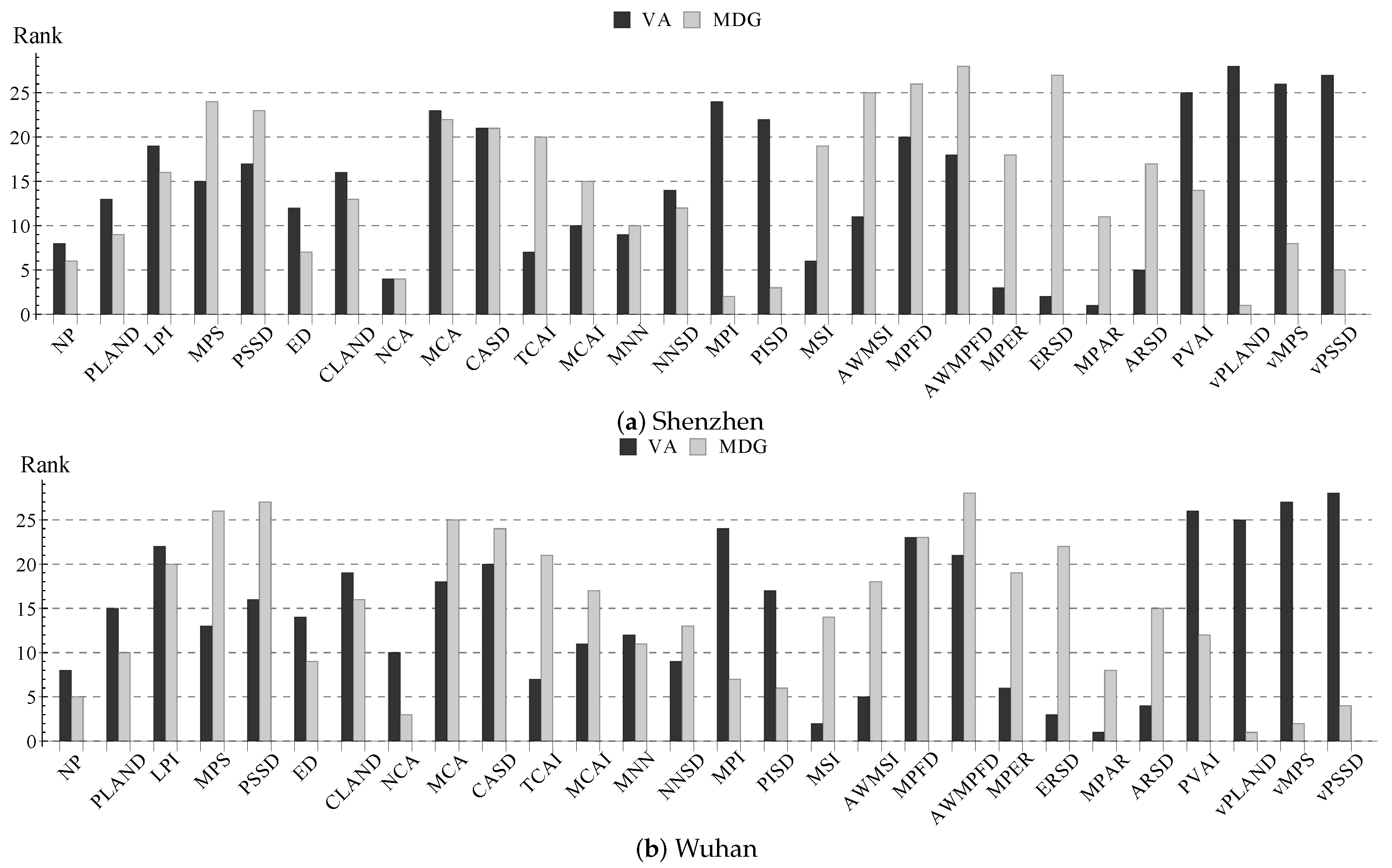
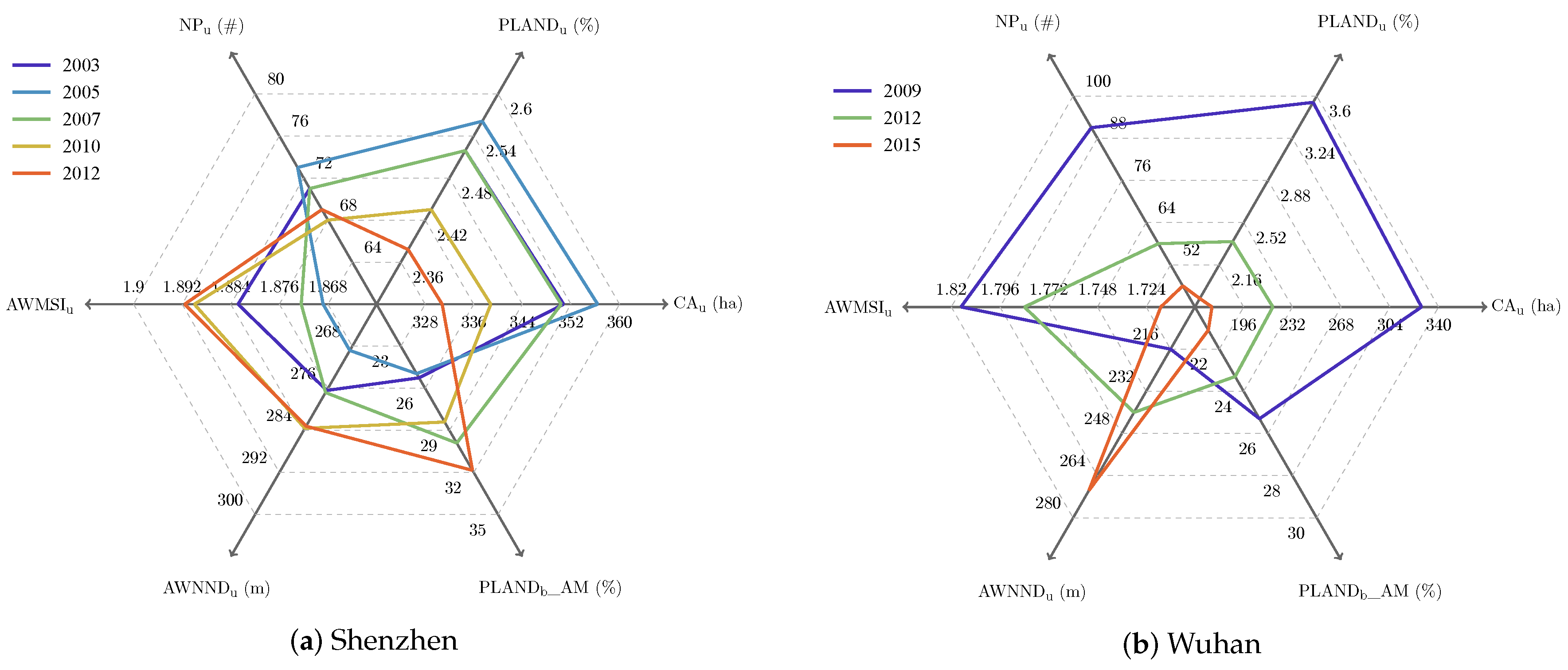
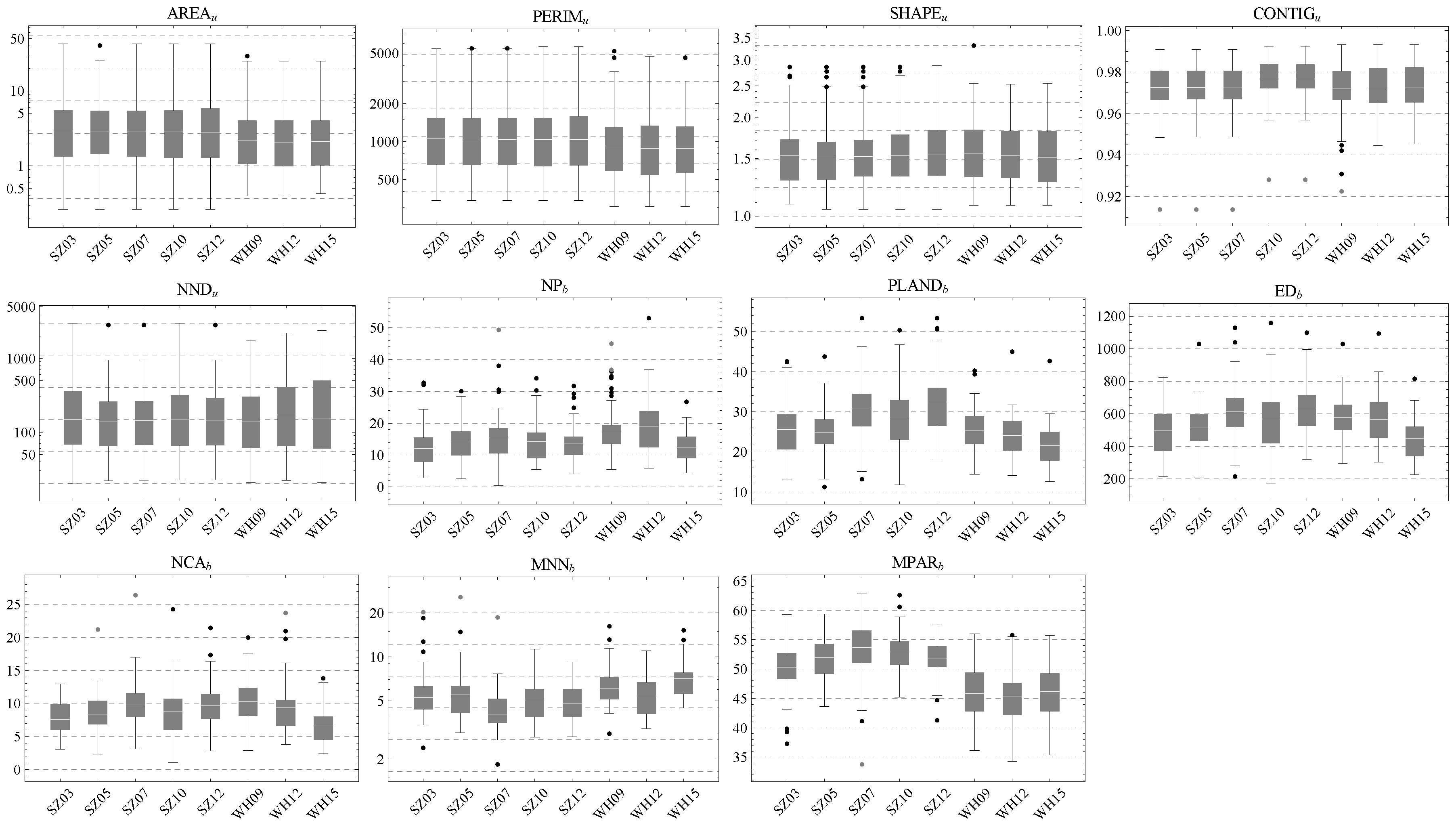
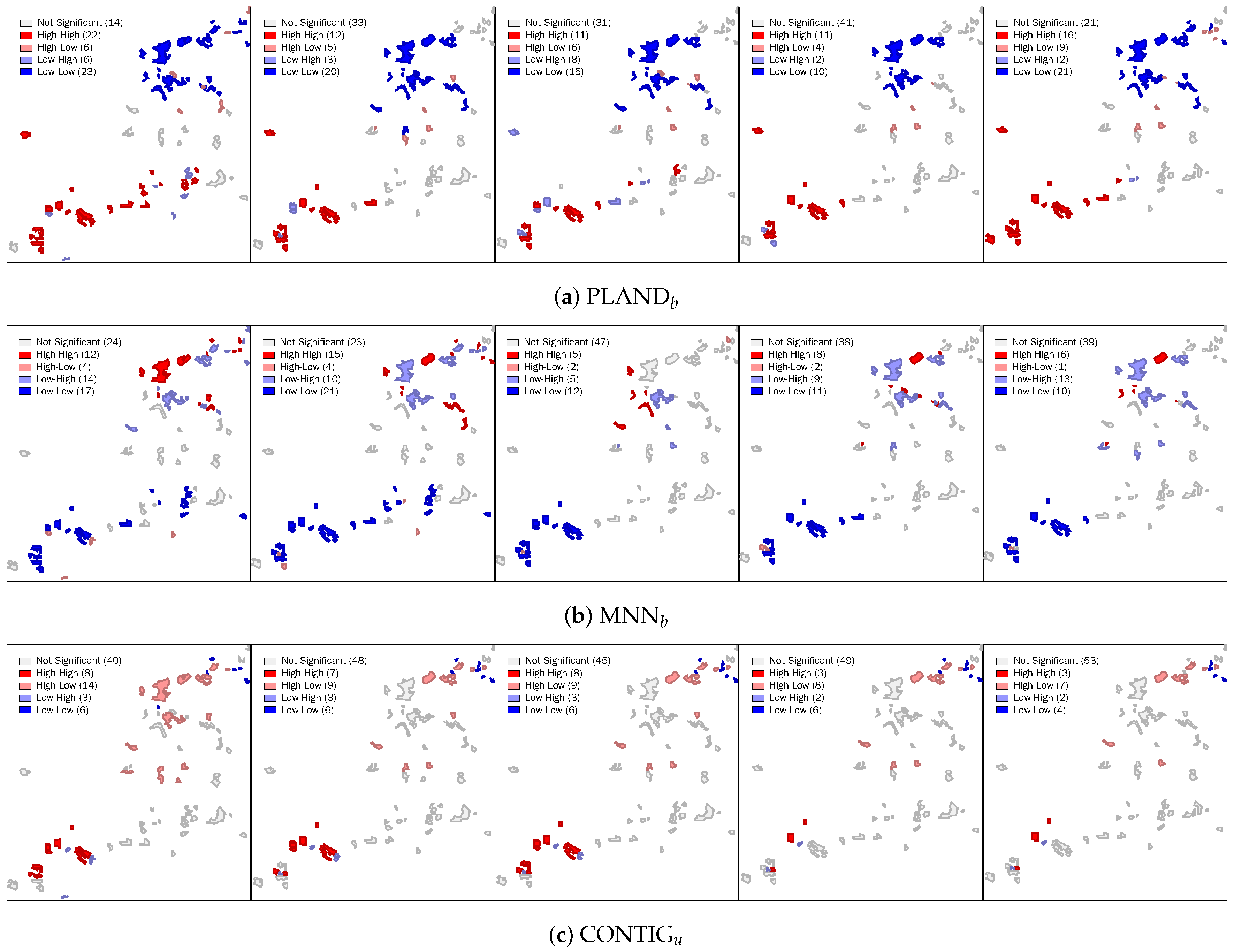
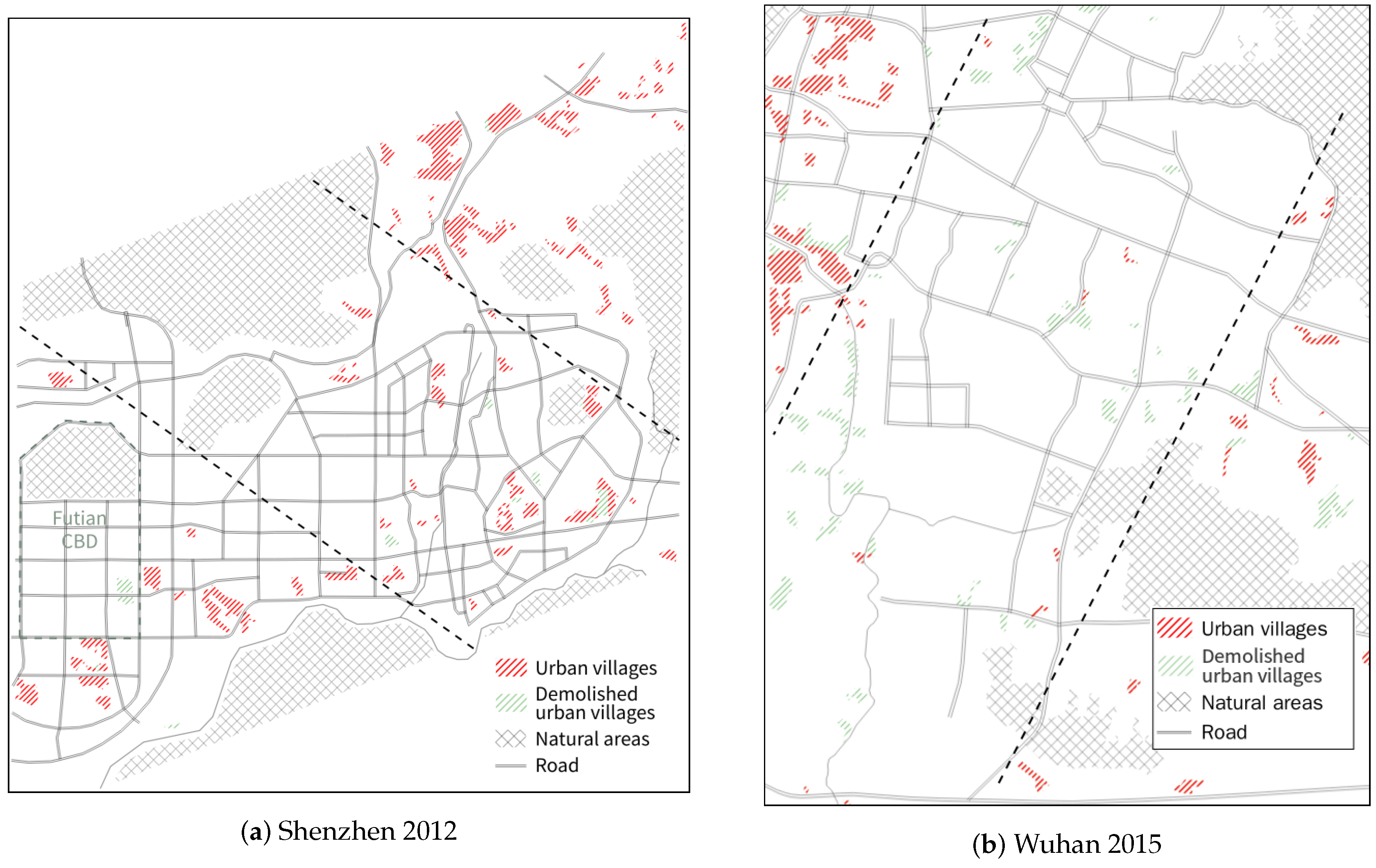
| Study Area | Satellite | Date | Resolution | Image Size (Pixel) |
|---|---|---|---|---|
| Shenzhen | QuickBird | January 2003 | 2.4 m | 5360 × 4507 |
| December 2005 | ||||
| December 2007 | ||||
| May 2010 | ||||
| WorldView-2 | November 2010 | 2 m | 6433 × 5409 | |
| March 2012 | ||||
| Wuhan | GeoEye-1 | January 2009 | 2 m | 5550 × 4156 |
| December 2012 | ||||
| WorldView-2 | November 2015 |
| Level | Abbrev. | Metric | Formula |
|---|---|---|---|
| AREA | Area of the UV (ha) | ||
| PERIM | Perimeter of the UV (m) | ||
| Patch | SHAPE | Shape Index of the UV | |
| CONTIG | Contiguity Index of the UV | ||
| NND | Distance to the nearest neighboring UV (m) | ||
| CA | Total area of UVs (ha) | ||
| PLAND | Percentage of UV areas in the city (%) | ||
| Landscape | NP | Number of UVs (#) | n |
| AWMSI | Area-weighted mean shape index | ||
| AWNND | Area-weighted nearest-neighbor distance |
| Abbrev. | Metric | Formula |
|---|---|---|
| NP | Number of patches (#) | n |
| PLAND | Percentage of landscape (%) | |
| LPI | Largest patch index (%) | |
| MPS | Mean patch size (ha) | |
| PSSD | Patch size standard deviation (ha) | |
| ED | Edge density (m/ha) | |
| CLAND | Core area percent of landscape (%) | |
| NCA | Number of core areas (#) | |
| MCA | Mean core area per patch (ha) | |
| CASD | Patch core area standard deviation (ha) | |
| TCAI | Total core area index (%) | |
| MCAI | Mean core area index (%) | |
| MNN | Mean nearest-neighbor distance (m) | |
| NNSD | Nearest-neighbor standard deviation (m) | |
| MPI | Mean proximity index | |
| PISD | Proximity index standard deviation | |
| MSI | Mean shape index | |
| AWMSI | Area-weighted mean shape index | |
| MPFD | Mean patch fractal dimension | |
| AWMPFD | Area-weighted mean patch fractal dimension | |
| MPER | Mean patch extent ratio | |
| ERSD | Patch extent ratio standard deviation | |
| MPAR | Mean patch aspect ratio | |
| ARSD | Patch aspect ratio standard deviation | |
| PVAI | Patch vegetation area index |
| Training Samples | QuickBird | QuickBird | QuickBird | WorldView-2 | WorldView-2 |
|---|---|---|---|---|---|
| Used in Classification | 2005 | 2007 | 2010 | 2010 | 2012 |
| 0.864 | 0.920 | 0.853 | 0.919 | 0.945 | |
| Target domain samples | 0.158 | 0.102 | 0.105 | 0.023 | 0.020 |
| 0.013 | 0.005 | 0.040 | 0.042 | 0.014 | |
| Source domain | 0.793 | 0.866 | 0.764 | 0.804 | 0.964 |
| samples without | 0.124 | 0.152 | 0.308 | 0.259 | 0.017 |
| sample weighting | 0.069 | 0.018 | 0.006 | 0.004 | 0.012 |
| Source domain | 0.936 | 0.983 | 0.909 | 0.953 | 0.968 |
| samples with | 0.010 | 0.005 | 0.038 | 0.006 | 0.001 |
| sample weighting | 0.028 | 0.007 | 0.029 | 0.025 | 0.019 |
| (The proposed) |
| Sample Sources | The Collection of Metrics | GeoEye-1 | GeoEye-1 | WorldView-2 |
|---|---|---|---|---|
| 2009 | 2012 | 2015 | ||
| Wuhan | Table 3 | 0.737 1 | 0.730 | 0.714 |
| Shenzhen + Wuhan | Table 3 | 0.777 | 0.835 | 0.764 |
| Shenzhen + Wuhan | Propagated | 0.803 | 0.790 | 0.779 |
| Shenzhen + Wuhan | Reduced by VA | 0.794 | 0.812 | 0.665 |
| Shenzhen + Wuhan | Reduced by MDG | 0.794 | 0.779 | 0.765 |
| City | Year | NP | PLAND | ED | NCA | MNN |
|---|---|---|---|---|---|---|
| 2003 | 0.17 ‡ | 0.4 ‡ | 0.38 ‡ | 0.29 ‡ | 0.12 ‡ | |
| 2005 | 0.03 | 0.16 ‡ | 0.18 ‡ | 0.19 ‡ | 0.08 ‡ | |
| Shenzhen | 2007 | 0 | 0.08 ‡ | 0.07 † | 0.05 † | 0.04 † |
| 2010 | 0.05 † | 0.16 ‡ | 0.17 ‡ | 0.2 ‡ | 0.06 † | |
| 2012 | 0 | 0.2 ‡ | 0.19 ‡ | 0.19 ‡ | 0.05 † | |
| 2009 | 0.07 ‡ | −0.05 | −0.04 | 0.01 | −0.02 | |
| Wuhan | 2012 | 0.14 ‡ | 0.08 † | 0.13 ‡ | 0.15 ‡ | 0.09 † |
| 2015 | 0.06 | 0.06 | 0.02 | 0.06 | −0.01 |
© 2017 by the authors. Licensee MDPI, Basel, Switzerland. This article is an open access article distributed under the terms and conditions of the Creative Commons Attribution (CC BY) license (http://creativecommons.org/licenses/by/4.0/).
Share and Cite
Liu, H.; Huang, X.; Wen, D.; Li, J. The Use of Landscape Metrics and Transfer Learning to Explore Urban Villages in China. Remote Sens. 2017, 9, 365. https://doi.org/10.3390/rs9040365
Liu H, Huang X, Wen D, Li J. The Use of Landscape Metrics and Transfer Learning to Explore Urban Villages in China. Remote Sensing. 2017; 9(4):365. https://doi.org/10.3390/rs9040365
Chicago/Turabian StyleLiu, Hui, Xin Huang, Dawei Wen, and Jiayi Li. 2017. "The Use of Landscape Metrics and Transfer Learning to Explore Urban Villages in China" Remote Sensing 9, no. 4: 365. https://doi.org/10.3390/rs9040365




